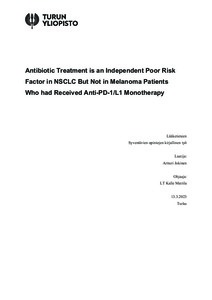Antibiotic Treatment is an Independent Poor Risk Factor in NSCLC But Not in Melanoma Patients Who had Received Anti-PD-1/L1 Monotherapy
Jokinen, Artturi (2023-02-24)
Antibiotic Treatment is an Independent Poor Risk Factor in NSCLC But Not in Melanoma Patients Who had Received Anti-PD-1/L1 Monotherapy
Jokinen, Artturi
(24.02.2023)
Julkaisu on tekijänoikeussäännösten alainen. Teosta voi lukea ja tulostaa henkilökohtaista käyttöä varten. Käyttö kaupallisiin tarkoituksiin on kielletty.
avoin
Julkaisun pysyvä osoite on:
https://urn.fi/URN:NBN:fi-fe2023040635425
https://urn.fi/URN:NBN:fi-fe2023040635425
Tiivistelmä
Background: Antibiotic treatment may reduce the efficacy of cancer immunotherapy by disrupting gut
microbiome. We aimed to study the association of antibiotics and survival outcomes in advanced
cutaneous melanoma and NSCLC patients who had received anti-PD-1/L1 monotherapy.
Patients and methods: 222 melanoma and 199 NSCLC patients had received anti-PD-1/L1 monotherapy in
five Finnish hospitals between January 2014 and December 2020. Clinical characteristics, antibiotic and
corticosteroid treatment, and survival outcomes were retrospectively collected from hospital and national
medical records.
Results: 32% of melanoma and 31% of NSCLC patients had received antibiotic treatment (ABT) three
months before to one month after the first anti-PD-1/L1 antibody infusion. In survival analyses, early
antibiotic treatment was associated with inferior OS (ABT 19.2 (17.6−43.7) vs no ABT 29.3 (35.6−NA)
months, p=0.033) but not with inferior PFS (ABT 5.8 (3.0−12.6) vs no ABT 10.2 (7.7−15.3) months, p=0.3) in
melanoma patients and with inferior OS (ABT 8.6 (6.4−12.3) vs no ABT 18.5 (15.1−21.6) months, p<0.001)
and PFS (ABT 2.8 (2.1−4.5) vs no ABT 5.6 (4.4−8.0) months, p=0.0081) in NSCLC patients. In multivariable
analyses, ABT was not an independent risk-factor for inferior OS and PFS in melanoma but was associated
with inferior OS (HR 2.12 (1.37−3.28)) and PFS (HR 1.65 (1.10−2.47)) in NSCLC after adjusted for other risk
factors.
Conclusions: Early ABT was an independent poor risk factor in NSCLC patients who had received anti-PD-
1/L1 monotherapy but not in melanoma patients. The weight of ABT as a poor risk factor might depend on
other prognostic factors in different cancers.
microbiome. We aimed to study the association of antibiotics and survival outcomes in advanced
cutaneous melanoma and NSCLC patients who had received anti-PD-1/L1 monotherapy.
Patients and methods: 222 melanoma and 199 NSCLC patients had received anti-PD-1/L1 monotherapy in
five Finnish hospitals between January 2014 and December 2020. Clinical characteristics, antibiotic and
corticosteroid treatment, and survival outcomes were retrospectively collected from hospital and national
medical records.
Results: 32% of melanoma and 31% of NSCLC patients had received antibiotic treatment (ABT) three
months before to one month after the first anti-PD-1/L1 antibody infusion. In survival analyses, early
antibiotic treatment was associated with inferior OS (ABT 19.2 (17.6−43.7) vs no ABT 29.3 (35.6−NA)
months, p=0.033) but not with inferior PFS (ABT 5.8 (3.0−12.6) vs no ABT 10.2 (7.7−15.3) months, p=0.3) in
melanoma patients and with inferior OS (ABT 8.6 (6.4−12.3) vs no ABT 18.5 (15.1−21.6) months, p<0.001)
and PFS (ABT 2.8 (2.1−4.5) vs no ABT 5.6 (4.4−8.0) months, p=0.0081) in NSCLC patients. In multivariable
analyses, ABT was not an independent risk-factor for inferior OS and PFS in melanoma but was associated
with inferior OS (HR 2.12 (1.37−3.28)) and PFS (HR 1.65 (1.10−2.47)) in NSCLC after adjusted for other risk
factors.
Conclusions: Early ABT was an independent poor risk factor in NSCLC patients who had received anti-PD-
1/L1 monotherapy but not in melanoma patients. The weight of ABT as a poor risk factor might depend on
other prognostic factors in different cancers.
